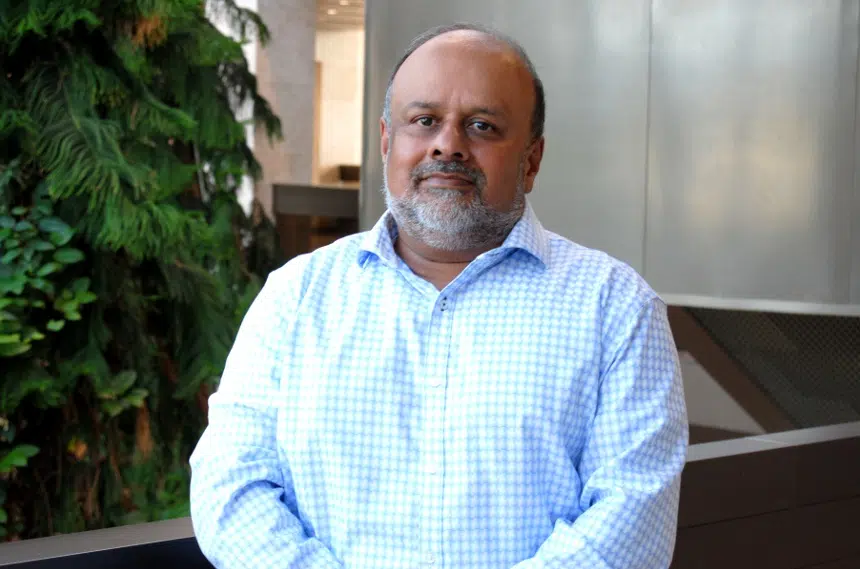Six months ago, many people in Saskatchewan had never heard of terms like social distancing or effective reproductive number. They never considered wearing a face mask to the grocery store.
Things have changed.
As of Saturday, Saskatchewan will have had six months of COVID-19 cases, with the provincial state of emergency hitting its six-month mark on Sept. 18.
As the province’s chief medical health officer, Dr. Saqib Shahab has been at the helm of the province’s response to the pandemic.
He has been working on it since before March, following news reports out of China at the end of December.
“But then by the middle of January, it was very clear that there was a significant issue in Wuhan, China and that they were really taking significant actions,” said Shahab.
Shahab said the scope of the situation was alarming.
He said February was concerning, the hardest month because health officials could see what was happening in China with the virus spreading globally.
“We knew that we would see transmission within Canada and then by that time, end of February, March, we were already seeing transmission picking up in Italy, other parts of the world, not just in China,” explained Shahab.
He said health professionals discovered that the virus was more like influenza, that it could spread quickly and couldn’t be “put back in the box” like SARS, so isolation for those who tested positive would be the game plan.
When the virus arrived in Saskatchewan on March 12, it was from someone who had just returned from Egypt.
The next week, the province closed schools and declared a state of emergency, something Premier Scott Moe said he couldn’t remember the province ever doing.
“Schools closed, my youngest who was in school was home, it was eerie driving to work because the roads were empty (and) shopping (centres were nearly empty). So it was very eerie. In some ways you at least had the satisfaction that you had the measures in place but it was also concerning because people were suffering because of job loss and economic activities,” said Shahab.
Eventually the restrictions were eased and the province opened up again bit by bit. It’s currently at the end of Phase 4 of the reopening plan. The minister of health recently said the government hasn’t even thought yet about moving into Phase 5, which would permit very large gatherings and easing of restrictions in long-term care homes.
There have been a few outbreaks, including in northern Saskatchewan and in communal living settings.
Looking back on the last six months, Shahab said he’s very proud of how northern leaders handled the outbreak.
“I was very concerned about how would things play out in northern Saskatchewan and First Nations communities. I think (there was) tremendous leadership from those communities. (They were) challenging circumstances, all the things related to household crowding,” said Shahab.
But overall Shahab said the province has done very well. He said it can be attributed, in part, to the wide open spaces in Saskatchewan, but also the diligence of people across the province following public health guidelines.
Shahab is the province’s top doctor but he’s also humble. When he was asked about the work he has had to put in or the stress of the job, he opted to talk about the work and sacrifices by everyone in health care.
“No one in public health has had a real vacation of a week or two weeks, but you are able to take a day or two off,” said Shahab.
“Something like this happens, you have to step up, and so does everyone else.”
Shahab did admit it has been busy for him, mentioning 20-hour days at first, but his schedule seems to have stabilized a bit.
He also pointed out that it’s not just a health-care response, that all of government had to step in and respond.
When it comes to a pandemic, Shahab said it’s something public health officials train for.
“We hope that we’ll all be retired by the time they come,” Shahab joked. “But we do plan for them and some of the plans actually … seem kind of odd, that you’ll close all schools, that most businesses will close, that only essential services will (stay open). They seem very odd and you kind of try to visualize, ‘How would that look?’ ”
Shahab said one of the biggest fears during a pandemic is that authorities would see a crisis in essential services but in Saskatchewan, grocery stores and gas stations were able to stay open and other industries like trucking and farming kept going.
There has been a bit of celebrity involved in the job for Shahab. He has been on nearly every update from the province broadcast over radio and online. There was even a Twitter account created in devotion to the cardigans Shahab wears.
Shahab said it has been interesting.
“People are generally very kind and they’ll wave and say, ‘Good job.’ So far, it has been mostly positive, which is good,” he said.
Now, Shahab is turning his thoughts to the next six months, which will include flu season. He recommends everyone consider getting vaccinated.
“That’s going to be really important because then that’ll reduce the burden of respiratory illness in general. And no one really knows how flu and COVID together behave,” he said.
He said everyone also needs to stay the course and keep up with the guidelines, especially as socializing moves indoors out of the cold.
“I’m really hopeful that we’re at the home stretch. Another five, six months and hopefully we’ll have a safe and effective vaccine and then that’ll really start changing how we need to live with COVID,” said Shahab.











